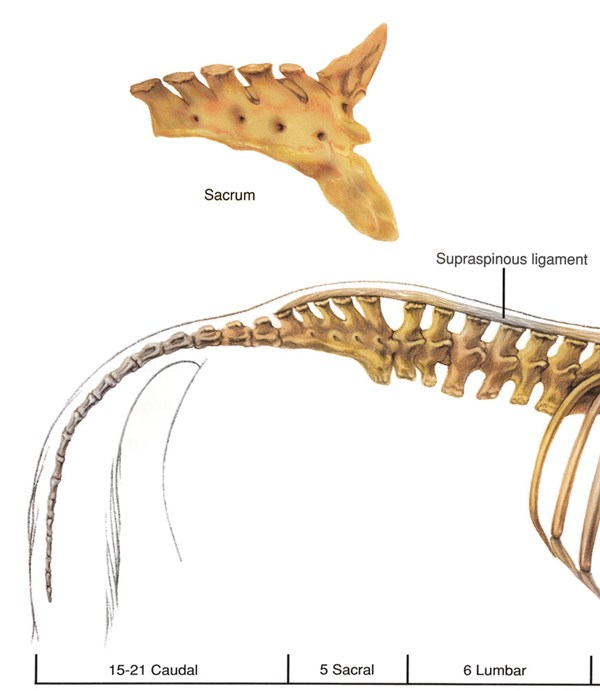
Sacroiliac pain is not an uncommon presentation in dressage horses, even at the lower levels. The horse who was doing well before is now grumpy and uncooperative, but without any obvious lameness. Listening to the client’s story, I will often hear that the horse doesn’t want to take the weight behind, he has become resistant or he bucks when asked to canter. Other signs include: moving short behind, lacking engagement and difficulty moving laterally. I will even see overt resistance in some horses—bucking or kicking out when asked to sit or canter. Unfortunately, from the diagnostic standpoint, this history is also consistent with other sources of discomfort. The next step is a physical examination that includes palpating the neck, back, pelvis and limbs. Pain on palpation over the sacroiliac joint, particularly on traction of the tuber sacrale (the top point of the croup) is consistent with sacroiliac inflammation though not present in all affected horses. Gluteal-muscle atrophy may be present. Moving, affected horses will usually be minimally lame and negative or slightly positive on hind-limb flexion tests. Occasionally, affected horses will trot off after flexion tests more lame in the leg they were standing on. If all cases were so straightforward, sacroiliac pain wouldn’t be a difficult diagnosis. However, it is rare to find a case of sacroiliac pain in isolation. A majority of the time it is associated with other causes of hind-limb pain. Sacroiliac pain is often associated with hock pain or proximal hind-suspensory pain, both of which can present similar clinical signs. You are often left at the end of the examination with an impression that the horse has a bilateral hind-limb lameness and clinical signs pointing to more than one location.
Sorting the puzzle can follow a couple of different paths, depending on the physical-exam findings, previous treatment and the client’s desires. Since hock pain is the most common cause of bilateral hind-limb lameness, and hock pain is often associated with sacroiliac pain, the horse presented to me for reluctance to sit has often already had his hocks injected. A partial response or no response to hock injections will move sacroiliac pain up my rule-out list. Using nerve or joint blocks bilaterally to look for improvement in the movement, are also an option and one I am likely to consider if I have any indication of hind-suspensory pain. Medical imaging can be useful as well. An ultrasound of the lumbosacral joint and sacroiliac joint can help identify abnormalities, though an absence of findings does not rule out sacroiliac pain. A bone scan can be quite helpful, showing inflammation in the sacroiliac joint and other possible contributing factors. It is the exception, in my practice, to have a horse who is just sore in his sacroiliac joint. Working through the performance issue is often a case of treating the clinical abnormalities until the horse responds.
Treatment of the sacroiliac joint in my practice is primarily local ultrasound-guided injections or use of systemic bisphosphonates, Tildren or Osphos. Mesotherapy, acupuncture, chiropractic and nonsteroidals will also help certain horses, but haven’t been as consistently successful. Thanks to a few pioneers in our profession, recognition of this condition has dramatically increased over the course of my career. Diagnostic and treatment approaches have evolved and will continue to do so as sacroiliac pain is better understood.
Joe Davis, DVM, graduated from the veterinary school at the Virginia-Maryland Regional College of Veterinary Medicine in 1991. In 1997 he joined The Piedmont Equine Practice in The Plains, Virginia. He has a special interest in performance-horse medicine, lameness and chiropractic care. Horses have been a significant factor in his life as a rider, competitor in dressage and combined training and most recently as a Pony-Club father. His wife, Pam, is a small-animal veterinarian, and they have two daughters, Hayley and Kristina.











